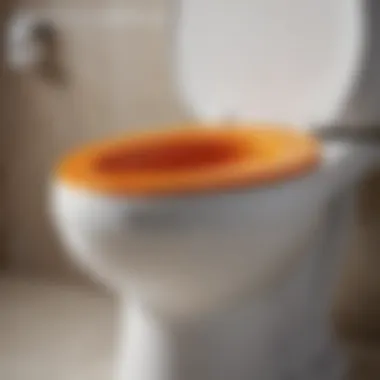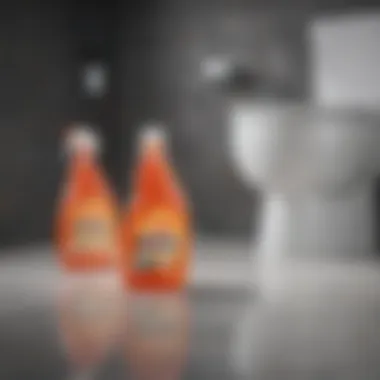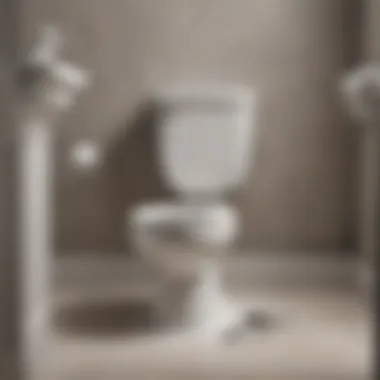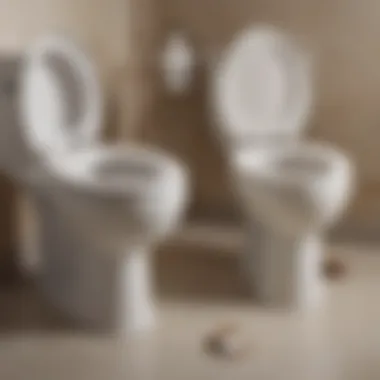Eliminating Toilet Stains: A Comprehensive Guide


Intro
Toilet stains can be an unsightly problem in any bathroom, often causing embarrassment and frustration. Understanding the types of stains, their causes, and how to effectively remove them is essential for maintaining a clean, hygienic environment. This guide delves into the various methods available to help you restore your toilet to its former glory.
Stains in toilets can originate from several sources, including mineral deposits, rust, and mold. Each of these requires a different approach to cleaning. Those who seek practical solutions will find the steps outlined here straightforward and clear. By employing the right cleaning agents and techniques, you can significantly improve the overall appearance of your toilet.
In this article, we will explore the following:
- Different types of toilet stains
- Recommended cleaning products and their proper usage
- Step-by-step instructions for effective cleaning techniques
The focus will be on actionable insights, designed to empower readers with the knowledge to tackle this household issue with confidence.
Understanding Toilet Stains
Toilet stains are often a source of frustration for homeowners. Understanding toilet stains is vital for maintaining a clean and hygienic bathroom. This section explores the various types and causes of toilet stains, offering insights that can assist in developing an effective cleaning regimen.
Knowledge of toilet stains aids in better selection of cleaning supplies and techniques since not all stains respond the same way to cleaning methods. By identifying stain types and their origins, one can prevent further staining and make cleaning less of a chore.
Common Types of Toilet Stains
Hard Water Stains
Hard water stains are formed when minerals in water, such as calcium and magnesium, precipitate out as the water evaporates. This results in a chalky residue that adheres to the toilet bowl.
These stains are a prominent concern due to their tendency to accumulate over time and create unsightly rings. The key characteristic of hard water stains is their stubbornness; they are often resistant to standard cleaning agents. Their presence is particularly common in areas with high mineral content in the water supply. Therefore, understanding hard water stains is beneficial for this article as it underscores the necessity for targeted cleaning solutions, such as stronger descalers or specific scrubbing techniques.
Mineral Deposits
Mineral deposits manifest similarly to hard water stains but may include a broader range of minerals. These deposits can appear as dark patches or crusty build-ups that develop in toilet bowls over time.
An important feature of mineral deposits is their varying colors, which may indicate different types of minerals, such as iron or manganese. Recognizing these stains is critical because each type may require a unique approach for effective removal. Acknowledging mineral deposits as significant contributors to toilet stains aids readers in identifying problems early, potentially saving time and cleaning efforts later.
Organic Stains
Organic stains refer to marks caused by biological materials such as algae, bacteria, or organic waste. These stains often emerge in toilets that are not cleaned regularly or in bathrooms with poor ventilation.
The defining characteristic of organic stains is their ability to not only discolor but also produce unpleasant odors. Effective removal includes both cleaning agents and thorough scrubbing. This information is vital, as eliminating organic stains requires not just cleaning solutions but a comprehensive understanding of the sources contributing to their formation. Such insights can guide readers in maintaining cleaner toilets over time.
Causes of Toilet Stains
Water Quality
Water quality plays a critical role in the type and frequency of toilet stains. Hard water, characterized by high mineral content, can lead to more frequent and severe staining. Moreover, the presence of rust or other impurities in water can exacerbate staining issues.
Understanding the quality of water can help homeowners implement preventive measures like installing a water softener. The unique aspect of water quality lies in how it directly influences both the appearance and maintenance needs of toilet fixtures. Thus, this topic is critical as it provides actionable steps for improving bathroom cleanliness through better water management.
Usage Patterns
Usage patterns are another factor contributing to toilet stains. Toilets that see regular use may develop stains at different rates than those used sporadically. Frequent flushing prevents some staining but can lead to residue build-up if combined with lower water quality.
The relationship between usage patterns and staining can guide homeowners in establishing cleaning routines that are appropriate for their toilet’s usage. Recognizing how daily habits influence toilet maintenance empowers readers to take control of their cleaning schedules effectively.
Neglect and Maintenance
Neglect in toilet maintenance is perhaps the most straightforward cause of staining. A lack of regular cleaning allows stains to settle and become permanent. Infrequent cleaning often leads to a buildup of hard water stains and organic residues.
The main feature here is the concept of proactive care versus reactive measures. By instilling a regular maintenance routine, homeowners can significantly reduce the occurrence of stubborn stains. It is crucial for this article to emphasize the importance of ongoing toilet care, as neglect leads to more formidable cleaning challenges later.
Assessing Cleaning Supplies
Assessing cleaning supplies is an essential aspect when it comes to maintaining a clean toilet. Choosing the right products can make the difference between a visibly spotless toilet and one that still carries stains and odors. Here, we will explore the various cleaning agents available and evaluate their suitability for toilet cleaning.


Commercial Cleaners: Pros and Cons
Effectiveness
Commercial cleaners are specifically formulated to tackle toilet stains. Their effectiveness is seen in how quickly they can break down tough stains caused by hard water and mineral deposits. Many contain strong chemicals that can penetrate and dissolve stains efficiently. This characteristic makes them a popular choice among many homeowners. However, their strength can sometimes be a double-edged sword. The harsh ingredients may raise concerns about safety and long-term impacts on plumbing and the environment.
Environmental Impact
Many people are increasingly concerned about the environmental effects of their cleaning products. Commercial cleaners often contain harsh chemicals that can pollute water sources when disposed of. This aspect of environmental impact is key for those looking to keep their ecological footprint low. At times, the packaging of these products also contributes to waste. Opting for environmentally friendly cleaners can mitigate these effects, but they may not always match the potency of conventional options. This can lead consumers to weigh the pros and cons of effectiveness and environmental responsibility in their cleaning choices.
Cost Considerations
Cost is a significant factor that drives choices in cleaning supplies. Commercial cleaners vary widely in price. Some are affordable, while others, particularly premium brands, can be quite expensive. When evaluating cost considerations, it's vital to recognize the value they provide. A higher price might come with features like eco-friendly formulas or added ingredients that prevent future stains. However, for those on a budget, it may also lead to selecting less effective or cheaper cleaning solutions, which could result in higher ongoing maintenance costs. Finding that balance is essential.
Homemade Cleaning Solutions
Baking Soda and Vinegar
Baking soda and vinegar rank among the most popular homemade solutions for cleaning toilets. Their effectiveness comes from a simple chemical reaction when combined. This mixture can lift stains and neutralize odors. This method is appealing because it uses natural ingredients that are readily available in most homes. However, while this combination is effective on various stains, it may not address more severe or persistent staining situations.
Borax
Borax is another home cleaning agent that has gained popularity for toilet maintenance. Its unique properties allow it to clean and deodorize simultaneously. Borax can sanitize toilet bowls, effectively removing stains with minimal scrubbing needed. It is easy to use, and it is a more affordable option compared to many commercial cleaners. However, its strong alkaline properties may not be suitable for all plumbing systems, leading some to consider other alternatives if they have specific plumbing concerns.
Lemon Juice
Lemon juice is valued for its natural antibacterial and stain-fighting properties. It can cut through hard water stains and leave a pleasant citrus scent. This makes it a desirable choice for individuals seeking a fresher bathroom environment. However, lemon juice can be less effective against robust stains compared to stronger chemical cleaners. Its acidity can also lead to wear on certain materials over time, so care must be taken when selecting this method.
Practical Cleaning Techniques
Understanding and applying practical cleaning techniques is crucial for maintaining a hygienic toilet. This section covers essential methods that can be used to effectively combat various stains. By focusing on proper cleaning procedures, individuals can enhance the cleanliness of their bathrooms while prolonging the lifespan of their fixtures. Learning these techniques can save time and resources, ensuring that the toilet remains in top condition.
Preparing for Cleaning
Gathering Supplies
Gathering supplies is the first step in the cleaning process. This aspect emphasizes the necessity of having the right tools and materials ready before starting any cleaning task. Key components may include toilet brushes, cleaning agents like bleach or vinegar, gloves, and a scrub brush. Having these items at hand allows for a more efficient and effective cleaning experience.
A well-prepared cleaning kit significantly contributes to overall cleanliness. It allows the user to tackle stains promptly and with confidence. However, it is important to keep in mind that certain cleaning agents can be harsh or require specific handling. Thus, understanding the safety aspects associated with each supply is vital.
Safety Precautions
Safety precautions are another critical aspect to consider. When cleaning the toilet, the use of protective gear like gloves is essential. This prevents direct contact with potentially harmful chemicals or bacteria. Taking safety seriously can prevent accidents or irritations that might occur from using strong cleaning agents.
In this context, the unique feature of safety precautions is their preventive nature. They not only protect the individual but also ensure that the cleaning process is carried out more smoothly. However, one disadvantage can be the additional time taken to prepare. This step should not be overlooked.
Creating a Cleaning Schedule
Creating a cleaning schedule is highly beneficial for long-term maintenance. Regular cleaning helps prevent the build-up of stains and ensures that the toilet remains in good condition. A structured approach to cleaning can eliminate the problem of neglect, which often leads to hard-to-remove stains.
The key characteristic of a cleaning schedule is its systematic nature. It allows individuals to plan out tasks and manage their time effectively. However, the disadvantage is that some may find it cumbersome to stick to a schedule. Finding a balance between a routine and flexibility might be necessary for effectiveness.
Step-by-Step Cleaning Process
Applying Cleaning Agents
Applying cleaning agents properly contributes significantly to the effectiveness of the cleaning process. Each agent has its own application method and dwell time, which are crucial for optimal results. For instance, bleach may need to sit for a short duration to disinfect, whereas vinegar can help dissolve mineral deposits over time.
The key characteristic here is the variation in application methods. Understanding how to apply different agents allows individuals to choose the most appropriate one for their specific stains. That being said, overuse of harsh chemicals can lead to plumbing issues; thus, moderation is recommended.
Scrubbing Techniques
Different scrubbing techniques can greatly influence the outcome of the cleaning process. The type of scrub brush or toilet brush used can affect how easily stains are removed. Using the right technique, like circular motions or back-and-forth scrubbing, can maximize effectiveness while minimizing wear and tear on the toilet surface.


One unique feature here is the specificity of techniques tailored to various stain types. Tailoring the scrubbing technique according to the stain can yield better results. Still, improper techniques may cause scratches or damage, making it necessary to exercise caution.
Final Rinsing
Final rinsing is an important step that is often overlooked. After cleaning, it is essential to rinse the toilet thoroughly to remove any residue or cleaning agent. This step ensures that nothing harmful remains that could impact health or plumbing systems.
The key characteristic of final rinsing is its ability to provide a clean finish. Ensuring no remnants of cleaning agents are left behind is crucial for hygiene. However, one disadvantage may be the potential for water waste during this process, which should be monitored.
Dealing with Stubborn Stains
Using Pumice Stones
Using pumice stones is a technique that focuses on removing stubborn stains that regular scrubbers might not tackle. By gently rubbing the stone against the stain, it can effectively lift deposits without scratching the ceramic. This process is particularly useful for mineral stains often caused by hard water.
The unique feature of pumice stones is their abrasive nature, making them ideal for tough stains. However, users must be cautious not to apply excessive pressure, as this can lead to surface damage over time.
Prolonged Soaking Methods
Prolonged soaking methods involve leaving a cleaning solution in the toilet for an extended period. This can be particularly effective for tough stains that require more attention than typical cleaning methods can offer. Solutions like a mixture of vinegar and baking soda for several hours can loosen deposits.
The efficiency of this method is notable, as it allows the solution to work on the stains without constant physical effort. The disadvantage, however, is the waiting time involved, which might not be feasible for everyone.
Seeking Professional Help
Sometimes, the best approach to tackle severe stains is to seek professional help. Professional cleaning services have access to specialized products and equipment that can successfully remove difficult stains. They bring expertise to handle problems that might overwhelm a standard approach.
While the unique feature of seeking professional help is the expertise and advanced tools they offer, this option can become a costly investment. Thus, individuals must weigh the need against their budget.
Preventive Measures
Preventive measures are critical for maintaining the cleanliness of toilets and reducing the frequency and intensity of stains. Regular upkeep minimizes the long-term impact of factors that contribute to staining. A proactive approach not only enhances the aesthetic of your bathroom but also promotes a healthier environment. Below are essential strategies to prevent toilet stains effectively.
Regular Maintenance Tips
Routine Cleaning Schedule
Having a routine cleaning schedule is essential for keeping toilets in prime condition. Establishing a cleaning frequency—whether it be weekly, bi-weekly, or monthly—depends on the usage patterns and water quality in your area. This approach ensures that stains do not have time to set in, making them easier to remove.
A key characteristic of a routine schedule is consistency. It is a beneficial choice as it prevents the build-up of hard water deposits and organic stains. By incorporating scheduled cleanings into your household routine, you can maintain an aesthetically pleasing and hygienic toilet.
However, it's crucial to balance the cleaning frequency with realistic expectations; for some, overwhelming cleanliness efforts can become a hassle.
Identifying Early Signs of Staining
Recognizing early signs of staining is another vital aspect of toilet maintenance. This skill entails monitoring the toilet bowl for any changes in color or texture. Early detection allows for swift action, preventing deeper set-in stains.
The key characteristic here is vigilance. Identifying stains early is beneficial because it provides the opportunity to react before stains become entrenched. Regular checks not only prolong the cleanliness but also save on extensive cleaning later. The downside might be the need for consistent attention, which some may find tedious.
Using Toilet Cleaners Regularly
Employing toilet cleaners regularly can significantly help in preventing stains. Applying cleaning agents specifically designed for toilets helps combat mineral deposits and organic material that lead to staining.
The unique feature of frequent cleaner use lies in its preventive abilities. Regular use sustains a fresh appearance and deters the development of hard-to-remove stains. However, some harsh cleaners can damage plumbing systems or may contain harmful chemicals, making it essential to choose products wisely.
Improving Water Quality
Water quality plays a pivotal role in the occurrence of toilet stains. If poor water quality is an ongoing issue, it can lead to accelerated staining and damage over time. Thus, taking steps to improve water quality can eliminate many of the staining problems.
Installing Water Softener Systems
Installing water softener systems can address issues related to hard water, which are common culprits of toilet stains. These systems reduce the minerals, like calcium and magnesium, often found in water.
One of the most appealing aspects of softeners is their effectiveness in prolonging the lifespan of plumbing and fixtures while reducing mineral build-up. However, they require a financial investment and periodic maintenance, which some homeowners might find challenging.
Understanding Local Water Quality
Being informed about local water quality can be very helpful. Knowing the characteristics of your water, such as its hardness or contaminants, aids in identifying potential staining issues.
This knowledge is beneficial as it allows individuals to tailor their cleaning routine and preventive measures accordingly. However, resources to obtain this information vary, and not all may have easy access to such data.
Periodic Testing of Water
Periodic testing of water is essential for understanding its quality and identifying any changes that may impact toilet cleanliness. Testing can reveal high levels of minerals or contaminants not visible to the naked eye.
The unique aspect of testing water regularly provides valuable insights into necessary preventive actions you may need to take. Although testing is often an overlooked step, it is an empowering choice that can lead to improved household management. The downside may be the need for equipment or professional assistance, which adds to the cost of maintenance.
Environmental Considerations


Understanding the environmental impact of cleaning methods is crucial in today's context. The choices made during cleaning contribute significantly to our ecological footprint. This section delves into eco-friendly options that reduce harm to the environment while ensuring effective stain removal. By prioritizing sustainability, individuals can maintain hygiene without compromising environmental integrity.
Choosing Eco-friendly Products
Opting for eco-friendly cleaning products aligns with both personal health and environmental well-being. These products often possess lesser harmful chemicals, making them safer for household use. It is essential to find options that maintain efficacy while minimizing environmental damage.
Identifying Green Certifications
Green certifications play a vital role in guiding consumers towards environmentally-friendly choices. Products with these certifications have undergone rigorous assessments to confirm their eco-friendly claims.
Key characteristics of these certifications include third-party verification, sustainable sourcing, and reduced toxicity. Such attributes make certified products a beneficial choice for cleaning toilets. The unique feature of these certifications lies in promoting accountability among manufacturers, encouraging transparency about product contents. This ensures the consumer is armed with adequate information to make informed decisions, thus reducing the risk of using harmful substances in their cleaning routine.
Understanding Ingredients
Recognizing the ingredients in cleaning products can influence a consumer's choice significantly. Products that utilize botanical and biodegradable materials are generally preferable because they often have lower toxicity levels.
The main advantage of understanding these ingredients is that it helps in making informed decisions. Eco-conscious customers can identify which components are harmful to both health and the environment. However, some eco-friendly ingredients may require different application methods or take longer to yield results. Adopting these products entails a slight adjustment in cleaning strategies, but it can lead to a healthier living environment overall.
Impact on Plumbing Systems
When discussing the impact of cleaning products on plumbing systems, the focus is on avoiding corrosive and hazardous materials. Many eco-friendly products are designed to be gentle on plumbing, preventing damage caused by harsh chemicals.
The main benefit of this consideration is the longevity of plumbing systems. Using safer alternatives can lead to reduced wear and tear on pipes, which minimizes expensive repairs. On the contrary, some eco-friendly products may not have the same level of effectiveness against severe stains, thus requiring more frequent applications. Nonetheless, being mindful of plumbing health is an essential factor in choosing cleaning methods.
Waste Disposal Practices
Proper disposal practices are equally important in reducing environmental harm. Disposing of cleaning agents responsibly ensures that harmful substances do not negatively impact water supplies or local ecosystems.
Proper Disposal of Cleaning Agents
Understanding how to dispose of cleaning agents is a critical responsibility for conscious consumers. Many commercial cleaning products contain toxic substances that should never go down the drain.
The key characteristic of proper disposal is adherence to local waste management regulations. Using designated disposal sites for hazardous waste is a preferred method. A unique aspect of this practice is its role in minimizing the ecological footprint. Following guidelines prevents contamination of waterways and soil, thus protecting local wildlife and ecosystems.
Environmental Regulations
Environmental regulations exist to protect the ecosystem from harmful practices, including improper waste disposal. These regulations dictate how cleaning products should be safely discarded.
Being aware of these regulations is beneficial for compliance and environmental health. This knowledge helps consumers make choices that align with local laws, promoting sustainable community practices. However, adhering to regulations can sometimes limit product options available to consumers, which may require additional effort to ensure compliance.
Community Resources
Community resources are valuable for those looking to dispose of cleaning products responsibly. Many localities offer programs that facilitate the safe disposal of hazardous waste.
The main advantage of utilizing these community resources is designed disposal sites that protect public health and the environment. However, access to such resources can vary by location, which may pose a challenge for some individuals. Seeking out local programs can enhance community engagement while reducing individual ecological impacts.
Finale and Final Thoughts
Understanding the factors that contribute to toilet stains is essential for effective cleaning and maintenance. This article has taken an in-depth look at various types of stains and their causes, as well as the cleaning supplies and techniques available. With knowledge of hard water stains, mineral deposits, and organic stains, homeowners are better equipped to identify issues and address them promptly. The discussion on both commercial and homemade cleaning solutions offers practical options that cater to diverse preferences while taking environmental considerations into account.
It is important to note that maintaining a clean toilet goes beyond superficial cleaning; it fosters a hygiene-conscious environment that affects the overall health of your bathroom. Regular maintenance not only prolongs the life of the toilet but also enhances its aesthetic appeal. An informed approach towards water quality, routine cleaning schedules, and understanding the impact of substances introduced into the system can be pivotal.
Proper care and preventive measures can significantly reduce the incidence of stubborn stains, leading to a more pleasant user experience.
This final section reinforces the critical elements of cleanliness, shifting the narrative from mere cleaning techniques to a holistic understanding of toilet care. As such, the goal is to motivate proactive steps towards ongoing maintenance rather than merely reacting to stains as they arise.
Summary of Key Points
To summarize:
- Types of Stains: Hard water stains and mineral deposits are the most common, caused primarily by water quality. Organic stains can stem from user habits.
- Cleaning Supplies: Both commercial cleaners and homemade solutions have unique strengths. Diversifying your cleaning arsenal can enhance effectiveness.
- Technique and Maintenance: Rigorous cleaning processes and regular maintenance schedules ensure cleanliness is not just an occasional task, but a part of daily life.
Encouragement for Ongoing Maintenance
Maintaining a clean toilet is not a one-time task. Ongoing maintenance is essential for keeping toilets stain-free and hygienic. Establishing a routine cleaning schedule is a crucial step. By committing to regular cleaning, the risk of stubborn stains significantly reduces. Simple actions, like using toilet cleaners regularly, checking for early signs of staining, and understanding local water quality, provides a robust defense against stains.
Also, consider educating every member of the household about proper toilet usage practices. Shared accountability can lead to better overall hygiene and maintenance.
Ultimately, investing time in toilet maintenance is a small price to pay for a healthy and visually appealing bathroom environment. Engage in this thoughtful endeavor and watch your toilet remain pristine.







